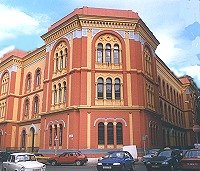Youth Group Members to fly 70 kites (August 3, 2011 – Jerusalem) Tomorrow, Thursday, August 4, Yad Vashem will mark 69 years since the deportation to Treblinka of Janusz Korczak, Stefa Wilczynska, and the children of their orphanage, from the Warsaw Ghetto. The memorial ceremony will be held at 17:00 at Janusz Korczak Square at Yad Vashem. As part of a workshop to take place during the course of the day, counselors of the HaMachanot HaOlim youth movement will hear the testimony of Holocaust survivor Yitzhak Belfer,
who resided in Korczak’s orphanage in Warsaw.
Belfer (88), Janusz Korczak’s student who will
participate in the ceremony, said, “I had a great love for Dr. Korczak. I was
seven years old when I arrived at the orphanage, and was granted the opportunity
to be educated under him for eight of the most important years of my life. The
doctor walked among us like any other person, never patronizing – spreading love
and concern for the children’s needs. In the orphanage we learned to believe in
people, in the good inclination that exists within us.”.
“Just as the sea gives a child a toy – a boat, so the
wind has to give him a kite,” — Janusz Korczak, The Religion of the
Child
At the conclusion of the ceremony HaMachanot HaOlim
counselors will fly 70 kites, .in Janusz Korczak’s unique worldview, in
order to convey to the world a message of dignity, love and rights equality.
Janusz Korczak was
the pen name of Henryk Goldszmit, a Polish-born doctor, author and educator.
Born in Warsaw
to an assimilated Jewish family, Korczak dedicated his life to caring for
children, particularly orphans. He believed that children should always be
listened to and respected, and this belief was reflected in his work. He wrote
several books for and about children, and broadcast a children’s radio program.
In 1912 Korczak became the director of a Jewish orphanage in Warsaw. When World War II
broke out in 1939, Korczak first refused to accept the German occupation and
heed their regulations (consequently spending time in jail). However, when the
Jews of Warsaw were forced to move into a ghetto, Korczak refocused his efforts
on the children in his orphanage. Despite offers from Polish friends to hide him
on the „Aryan” side of the city, Korczak refused to abandon the children.
Stefa Wilczynska was born in 1886 in Poland and completed her studies at the
University of Liège, Belgium. In 1909, she met Korczak and
the two began working together. When World War I began, Korczak was recruited
and Stefa remained in charge of running the orphanage, which had expanded and
now housed some 150 children. In 1935, she visited Eretz Israel and lived at Ein Harod until
1939. With the Nazi occupation, the members of Ein Harod arranged for her the
possibility of leaving Poland, but she turned it down and
moved to the ghetto along with Dr. Korczak and the children.
On August 5, 1942, during a 2-month wave of deportations
from the ghetto, the Nazis rounded up Korczak, Wilczynska and the 200 children
of the orphanage. They marched in rows to the Umschlagplatz with Korczak in the lead. He
and Stefa never abandoned the children, even to the very end. Korczak,
Wilczynska and the children were sent to Treblinka, where they were all
murdered.














